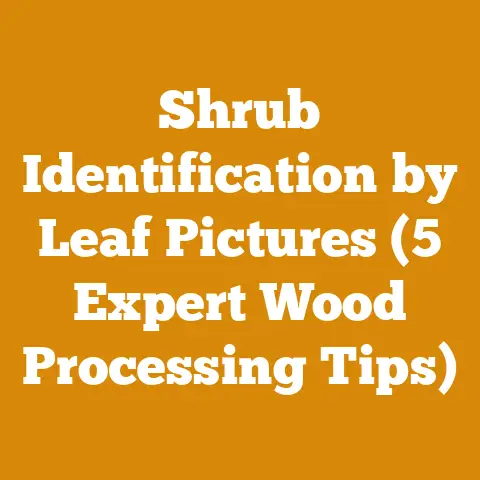Cast Iron Pot for Wood Stove Restoration (Rust Removal Tips)
Have you ever stumbled upon an old, rusty cast iron pot at a flea market or tucked away in your grandma’s attic and wondered if it could ever be brought back to life? I have – countless times! There’s something incredibly satisfying about taking a neglected piece of iron and restoring it to its former glory, especially when that glory involves sitting atop a roaring wood stove, radiating warmth and maybe even simmering a hearty stew. Today, I’m diving deep into the world of cast iron pot restoration, focusing specifically on rust removal techniques that will have your vintage cookware looking (and performing) like new.
Key Takeaways:
- Rust Removal is Key: Understanding different rust removal methods is crucial for successful restoration.
- Wood Stove Synergy: Restored cast iron pots are fantastic additions to any wood stove setup, improving heat distribution and offering cooking opportunities.
- Prevention is Better than Cure: Proper maintenance after restoration will prevent rust from returning.
- Safety First: Always prioritize safety when working with tools and chemicals.
- Patience Pays Off: Restoring cast iron takes time and effort, but the results are well worth it.
The Allure of Cast Iron and Wood Stoves: A Personal Journey
My fascination with cast iron began in my early teens. My grandfather, a seasoned logger with hands as rough as bark, had a collection of cast iron cookware that he used both indoors and on his outdoor wood-fired cooking setup. He taught me the basics: how to season a pan, how to regulate heat, and most importantly, how to respect the iron.
Fast forward a few years, and I found myself living in a drafty cabin in the woods, relying on a wood stove for heat. It was then that I truly understood the symbiotic relationship between cast iron and wood stoves. A cast iron pot filled with water or soup sitting on the stove not only added humidity to the dry winter air but also acted as a thermal mass, helping to distribute heat more evenly throughout the room. It was practical, efficient, and undeniably charming.
Over the years, I’ve experimented with various cast iron restoration techniques, learning what works and what doesn’t. I’ve rescued countless pots from the brink of oblivion, each one telling a story of its past life. And I’m excited to share my knowledge with you, so you can embark on your own cast iron restoration adventure.
Understanding the Enemy: What is Rust?
Before we dive into rust removal methods, let’s understand what we’re dealing with. Rust, chemically known as iron oxide, is the result of iron reacting with oxygen and water. This electrochemical process weakens the iron, causing it to flake and corrode. In the context of a cast iron pot, rust not only makes the pot unsightly but also compromises its structural integrity and cooking surface.
Data Point: According to the American Iron and Steel Institute (AISI), corrosion costs the U.S. economy over \$276 billion annually. While this figure encompasses all forms of corrosion, it highlights the significant economic impact of rust.
Assessing the Damage: Is Your Pot Salvageable?
Not all rusty pots are created equal. Before investing your time and effort, it’s crucial to assess the extent of the damage.
- Surface Rust: This is the most common type of rust, appearing as a light coating on the surface of the iron. Surface rust is usually easy to remove.
- Pitting: This occurs when rust has eaten into the iron, creating small pits on the surface. Minor pitting can be addressed, but severe pitting may compromise the pot’s structural integrity.
- Cracks or Warping: If the pot has any cracks or is significantly warped, it may not be worth restoring, especially if you plan to use it for cooking.
My Personal Rule of Thumb: If the rust is so severe that it has created holes or significantly weakened the iron, I consider the pot beyond repair. Safety should always be your top priority.
1. The Gentle Approach: Vinegar Soak
Vinegar, specifically white vinegar, is a mild acid that can effectively dissolve rust. This method is best for pots with light to moderate surface rust.
- Materials:
- White vinegar
- Water
- Large container (plastic or stainless steel)
- Scrub brush (stiff nylon or plastic)
- Baking soda
- Dish soap
- Clean cloths or paper towels
- Step-by-Step Instructions:
- Prepare the Solution: Mix equal parts white vinegar and water in the container. Make sure the container is large enough to fully submerge the pot.
- Soak the Pot: Submerge the rusty pot in the vinegar solution.
- Check Periodically: Check the pot every hour or two to monitor the rust removal process. The soaking time will vary depending on the severity of the rust, but it typically takes between 3 and 24 hours.
- Scrub the Rust: Once the rust has loosened, remove the pot from the vinegar solution and scrub it thoroughly with a scrub brush. The rust should come off relatively easily.
- Neutralize the Acid: Rinse the pot with water and then scrub it with a mixture of baking soda and water to neutralize any remaining vinegar.
- Wash and Dry: Wash the pot with dish soap and water, then dry it completely with a clean cloth or paper towels.
- Season Immediately: To prevent rust from reforming, season the pot immediately after drying (more on seasoning later).
Expert Insight: “Vinegar is a great option for removing light rust, but be careful not to soak the pot for too long, as it can damage the iron,” advises Sarah Jones, a renowned cast iron restoration expert and author of “The Cast Iron Cookbook.”
2. The Elbow Grease Method: Steel Wool and Oil
This method relies on good old-fashioned elbow grease and is best for removing surface rust or stubborn spots that the vinegar soak couldn’t handle.
- Materials:
- Steel wool (fine or medium grade)
- Cooking oil (vegetable, canola, or flaxseed)
- Clean cloths or paper towels
- Step-by-Step Instructions:
- Apply Oil: Apply a generous amount of cooking oil to the rusty areas of the pot.
- Scrub with Steel Wool: Scrub the rusty areas with steel wool, using firm, even pressure. The oil will help to lift the rust and prevent the steel wool from scratching the iron.
- Wipe Away Rust: As you scrub, wipe away the rust and oil with a clean cloth or paper towel.
- Repeat as Needed: Repeat the process until all the rust is removed.
- Wash and Dry: Wash the pot with dish soap and water, then dry it completely with a clean cloth or paper towels.
- Season Immediately: Season the pot immediately after drying.
Personal Anecdote: I once rescued a heavily rusted Dutch oven using this method. It took several hours of scrubbing, but the end result was well worth the effort. The key is to be patient and persistent.
3. The Abrasive Approach: Electrolysis
Electrolysis is a more aggressive method that uses an electric current to remove rust. It’s particularly effective for pots with moderate to heavy rust.
- Materials:
- Plastic container (large enough to hold the pot)
- Washing soda (sodium carbonate)
- Water
- Sacrificial anode (a piece of steel or iron)
- Battery charger (12-volt)
- Alligator clips
- Gloves
- Eye protection
- Step-by-Step Instructions:
- Prepare the Electrolyte Solution: Dissolve washing soda in water in the plastic container. The concentration should be about 1 tablespoon of washing soda per gallon of water.
- Set Up the Electrolysis Cell: Place the rusty pot in the container, ensuring it doesn’t touch the sacrificial anode.
- Connect the Electrodes: Connect the positive (+) terminal of the battery charger to the sacrificial anode and the negative (-) terminal to the cast iron pot. Make sure the connections are secure.
- Electrolyze: Turn on the battery charger. You should see bubbles forming on the surface of the pot. This indicates that the electrolysis process is working.
- Monitor the Process: Monitor the electrolysis process closely. The time required will vary depending on the severity of the rust, but it typically takes between 12 and 48 hours.
- Remove and Clean: Once the rust is removed, turn off the battery charger and carefully remove the pot from the electrolyte solution. The pot will be covered in a black sludge, which is the removed rust.
- Scrub and Rinse: Scrub the pot thoroughly with a scrub brush and rinse it with water.
- Dry and Season: Dry the pot completely and season it immediately.
Safety Note: Electrolysis produces hydrogen gas, which is flammable. Perform this process in a well-ventilated area and avoid sparks or open flames. Always wear gloves and eye protection when working with electrolysis.
4. The Heavy-Duty Option: Sandblasting
Sandblasting is the most aggressive method for removing rust and is best reserved for pots with extremely heavy rust or those that have been neglected for a long time. This method requires specialized equipment and should be performed by someone with experience.
- Materials:
- Sandblasting equipment
- Abrasive media (sand, glass beads, or aluminum oxide)
- Safety gear (respirator, eye protection, gloves)
- Step-by-Step Instructions:
- Prepare the Pot: Clean the pot as much as possible before sandblasting to remove any loose debris.
- Set Up the Sandblaster: Follow the manufacturer’s instructions for setting up the sandblaster.
- Sandblast the Pot: Sandblast the pot evenly, using a consistent distance and angle. Be careful not to focus on one area for too long, as this can damage the iron.
- Inspect the Pot: After sandblasting, inspect the pot for any remaining rust or damage.
- Clean and Season: Clean the pot thoroughly and season it immediately.
Professional Advice: “Sandblasting is a highly effective way to remove rust, but it can also be very abrasive. It’s important to use the right abrasive media and to have experience with the equipment to avoid damaging the cast iron,” says Mark Thompson, a professional metal restorer.
The Art of Seasoning: Creating a Non-Stick Surface
Once you’ve removed the rust, the next crucial step is seasoning. Seasoning is the process of baking thin layers of oil onto the cast iron to create a smooth, non-stick surface and protect it from rust.
- Materials:
- Cooking oil (flaxseed, canola, or vegetable)
- Clean, lint-free cloth or paper towels
- Oven
- Step-by-Step Instructions:
- Clean the Pot: Ensure the pot is completely clean and dry.
- Apply a Thin Layer of Oil: Apply a thin, even layer of cooking oil to the entire surface of the pot, inside and out. Use a clean cloth or paper towel to wipe away any excess oil. The goal is to have a very thin layer of oil, almost as if you’re wiping it off completely.
- Bake the Pot: Place the pot upside down on the middle rack of your oven. Place a baking sheet on the rack below to catch any drips.
- Set the Oven Temperature: Set the oven temperature to 450-500°F (232-260°C).
- Bake for One Hour: Bake the pot for one hour.
- Cool Down: Turn off the oven and let the pot cool completely inside the oven. This will help the oil to polymerize and create a hard, durable finish.
- Repeat the Process: Repeat the seasoning process 3-4 times to build up a good base layer.
Data Point: A study published in the “Journal of Food Science” found that seasoning cast iron with flaxseed oil resulted in a harder, more durable finish compared to other oils.
My Seasoning Secret: I prefer to use flaxseed oil for the initial seasoning layers, as it creates a very hard and durable finish. However, flaxseed oil can be prone to flaking if applied too thickly. So, I make sure to apply it in very thin layers. For subsequent seasoning layers, I switch to canola or vegetable oil, as they are more readily available and less prone to flaking.
Maintaining Your Restored Cast Iron Pot
Once you’ve restored and seasoned your cast iron pot, it’s important to maintain it properly to prevent rust from returning and to keep it in good condition for years to come.
- Clean After Each Use: Clean the pot immediately after each use. Use hot water and a scrub brush to remove any food residue. Avoid using soap unless absolutely necessary, as it can strip away the seasoning.
- Dry Thoroughly: Dry the pot completely after washing. You can dry it with a clean cloth or place it on a burner on low heat to evaporate any remaining moisture.
- Apply a Thin Layer of Oil: After drying, apply a thin layer of cooking oil to the entire surface of the pot.
- Store Properly: Store the pot in a dry place. If you’re storing it with other cookware, place a paper towel or cloth between the pot and other items to prevent scratches.
- Re-Season as Needed: If the seasoning starts to wear away or if you notice any rust forming, re-season the pot.
Expert Tip: “Regular use is the best way to maintain a cast iron pot. The more you cook with it, the better the seasoning will become,” says Chef Michael Smith, a renowned advocate for cast iron cooking.
Cast Iron Pots on Wood Stoves: A Match Made in Heaven
Now that you’ve restored your cast iron pot, it’s time to put it to good use on your wood stove. As I mentioned earlier, cast iron pots are a fantastic addition to any wood stove setup.
- Humidity Control: A pot of water on the wood stove adds humidity to the dry winter air, making your home more comfortable.
- Heat Distribution: Cast iron acts as a thermal mass, absorbing and radiating heat evenly throughout the room.
- Cooking Opportunities: You can use a cast iron pot to simmer soups, stews, or sauces on your wood stove.
- Aesthetic Appeal: A cast iron pot adds a touch of rustic charm to your wood stove setup.
Data Point: According to the U.S. Department of Energy, using a wood stove for supplemental heating can save homeowners up to 30% on their heating bills.
My Wood Stove Cooking Adventures: I’ve cooked countless meals on my wood stove using cast iron pots. From hearty chili in the winter to simmering apple cider in the fall, the possibilities are endless. One of my favorite things to do is to slow-cook a pot roast on the wood stove all day long. The low, consistent heat of the wood stove infuses the meat with incredible flavor.
Addressing Common Concerns
- “My pot is too far gone to restore.” While some pots may be beyond repair, don’t give up too easily. Even heavily rusted pots can often be salvaged with the right techniques and a lot of patience.
- “I’m afraid of damaging the pot.” It’s understandable to be cautious, especially when working with valuable vintage cookware. Start with the gentlest methods and gradually move to more aggressive techniques if necessary.
- “I don’t have the time or resources to restore a pot.” Restoring cast iron can be time-consuming, but it’s also a rewarding experience. If you don’t have the time or resources, consider hiring a professional metal restorer.
- “My seasoning is always sticky.” Sticky seasoning is usually caused by applying too much oil. Make sure to wipe away any excess oil before baking the pot.
- “My pot keeps rusting.” Rusting is usually caused by inadequate seasoning or improper cleaning and drying. Make sure to season the pot properly and to dry it thoroughly after each use.
The Global Perspective: Cast Iron and Wood Stoves Around the World
The use of cast iron pots on wood stoves is not limited to any one region or culture. Throughout history, people around the world have relied on cast iron cookware for its durability, versatility, and ability to retain heat.
- Scandinavia: In Scandinavian countries, cast iron pots are commonly used on wood stoves to cook traditional dishes like stews and porridge.
- Eastern Europe: In Eastern Europe, cast iron pots are often used to bake bread and other baked goods in wood-fired ovens.
- North America: In North America, cast iron pots are a staple of Southern cuisine and are often used to cook dishes like cornbread, fried chicken, and stews.
- Asia: In some parts of Asia, cast iron pots are used to cook rice and other grains over open fires.
Conclusion: A Rewarding Journey
Restoring a cast iron pot is a labor of love. It requires time, effort, and a willingness to get your hands dirty. But the end result is well worth it. You’ll have a beautiful, functional piece of cookware that will last for generations. And you’ll have the satisfaction of knowing that you’ve rescued a piece of history and given it a new lease on life.
So, go ahead, find that old, rusty cast iron pot and embark on your own restoration adventure. I promise you won’t regret it. And who knows, maybe you’ll even discover a newfound appreciation for the simple pleasures of cooking on a wood stove with a perfectly seasoned cast iron pot.






